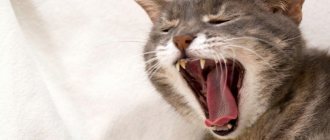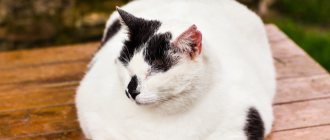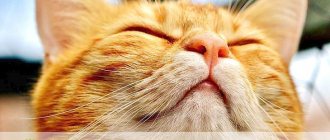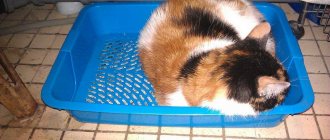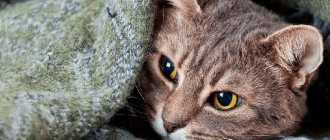Physiological reasons
In cats, as in humans, breathing through the nose is considered the physiological norm. It is not uncommon to see a cat breathing with its mouth open and its tongue hanging out like a dog. It is noticeable that with this method of breathing the abdominal muscles are involved: the cat breathes not from the chest, but from the stomach.
Nature has created a vacuum in the chest cavity around the lungs. When the pectoral muscles work while inhaling, the ribs diverge - the lungs straighten and fill with air, which enriches the blood with oxygen.
If there is a lack of oxygen, an “emergency” breathing mode is activated and the abdominal muscles are activated. The body tries to increase the amount of air inhaled - it increases breathing movements.
As soon as the oxygen level in the blood returns to normal, abdominal breathing “turns off” - the cat breathes calmly, through the chest, through the nose. If the animal does not have any pathological changes in the body, such conditions correspond to the norm and quickly pass when the negative factor is eliminated.
Natural external reasons why a cat breathes with its mouth open are:
- Hot. It is known that as the air temperature rises, the oxygen content decreases. The body's need for this element increases. The brain introduces a mode of “enhanced ventilation” - breathing becomes more frequent. Long-haired cats have a particularly hard time withstanding the heat: Maine Coons, Persians, Siberians. The owner's job is to keep the animal cool.
- Rapid breathing is often observed in cats that are obese. If a cat has suddenly gained weight, then you can often observe that the animal is breathing heavily with its mouth open. After the body adapts to the extra load or returns to normal (which is preferable), these phenomena disappear.
- After increased physical activity. Kittens are especially susceptible to this. Kids do not yet know how to regulate the load and after playing they get so tired that they “lay around without their hind legs” and often breathe with their mouths open and stick out their tongues. If the kitten breathes with an open mouth, then the reason for this may be irrepressible running and active play.
- Generic activity. During contractions and pushing, the uterus contracts, which limits the supply of oxygen to the organ. To avoid hypoxia in newborn kittens, the mother's body turns on increased breathing to protect the babies from suffocation. In this case, this is a necessary measure.
- The first time after giving birth and while feeding kittens, the cat may breathe rapidly with its mouth open, this is normal.
- Sexual hunting. During this period, the endocrine system of cats works in active mode: increased releases of sex hormones into the blood occur. Increased activity of the endocrine glands requires more oxygen - cats breathe frequently.
- Stressful situations. By frequent, heavy breathing with an open mouth, the animal’s body responds to psychological discomfort.
When these causes are eliminated, the cat quickly restores normal respiratory activity.
Why did the dog stick out its tongue?
Shortness of breath has several good causes. This is a mechanism that helps release heat from a dog's body. Dogs lower their body temperature in this process. Instead of sweating like humans, dogs stick out their tongues. The tongue secretes saliva along with the heat. Evaporation removes heat from the evaporation of a liquid substance or saliva. Evaporation in humans occurs in the form of sweat. On the other hand, dogs have sweat glands on their paws, which contradicts the popular belief that dogs do not have sweat glands. This symptom may be normal, or it may be pathology.
List of diseases in dogs that often cause tongue protrusion:
- Drooping Tongue Syndrome
- Mouth injury
- Behavioral disorder, stress, agitation
- Serious dental damage
- Oral cancer
- Fever
- Pain
You should consider tongue hanging out of your mouth as a disease
, only when the dog repeatedly demonstrates this behavior, even in a calm and comfortable situation. The disease Drooping Tongue Syndrome means a protruding tongue, which is exactly what the name of the disease is. Genetic pathology of small and brachycephalic dog breeds such as pugs.
Pathological causes
Rapid breathing with an open mouth and protruding tongue indicates a lack of air in the cat’s body - oxygen starvation. If the natural causes of this condition have been eliminated, and the cat continues to breathe too quickly, do not hesitate, you need to show the animal to a specialist.
The reason for this may be dangerous pathological conditions.
Pulmonary edema
When they talk about pulmonary edema, they mean excessive accumulation of fluid in the tissues of the organ. This is not an independent disease, but a symptom. In cats, pulmonary edema can develop for two reasons: cardiogenic (edema is provoked by some kind of cardiac pathology) and non-cardiogenic - caused by external influences.
Non-cardiogenic causes:
- hot air entering the respiratory tract;
- reaction to medications, including anesthesia;
- allergy;
- consequences of pneumonia or asthma;
- food poisoning or inhalation of toxic fumes;
- renal failure;
- head injury with damage to the brain and its membranes;
- blood poisoning;
- sun, heatstroke or electric shock.
Pulmonary edema develops very quickly, and if urgent rescue measures are not taken, the cat may die. This condition has pronounced symptoms and is easy to identify:
- the cat suddenly loses strength and stops responding to external stimuli;
- it is noticeable that the animal is having difficulty breathing;
- the animal coughs, breathes with its mouth slightly open, sticks out its tongue;
- mucous membranes rapidly turn pale, subsequently acquiring a bluish tint;
- when coughing, pinkish sputum appears - the result of injury to the alveoli;
- the initially rapid heartbeat weakens and becomes intermittent;
- As a result of impaired peripheral circulation, the cat's paws become cold.
Accumulation of fluid or air in the chest cavity
In case of injuries that are accompanied by damage to the skin and muscle frame or rib fractures, air can enter the cat's chest cavity. It prevents the lungs from fully expanding when inhaling. This condition is called pneumothorax.
Also, as a result of injury or internal bleeding, blood can enter the chest cavity. With various pathological conditions, there may be an accumulation of other body fluids, which interferes with the normal functioning of the cat’s lungs. This condition is called hydrothorax.
A cat can get rib fractures and penetrating wounds if it falls from a height or receives a strong blow. Only a veterinarian can determine what happened to the cat and why he is breathing with his mouth open. In case of injury, you should carefully lay the animal on its side, keep it still and urgently take it to the clinic.
State of shock
Shock is a common cause of sudden hypoxia. The threatening condition develops at lightning speed, and the following situations are the reason for its occurrence:
- injury;
- poisoning;
- allergic reaction;
- long-term infectious disease.
It is possible to bring a cat out of a state of shock only in a veterinary clinic. And if it is possible to get a shock in seconds, then getting out of it can take several days.
Foreign body in the respiratory tract
If during a meal the cat stops eating and begins to snort and cough, opens its mouth, you should watch it. Perhaps a piece of food got into the respiratory tract. He will come out soon and nothing bad will happen.
Also, during play, a small object may get into the cat’s throat.
If the cough does not stop, and wheezing is heard when breathing, and inhalation and exhalation become intermittent, do not hesitate! Probably, the foreign body has penetrated deep into the respiratory tract and can completely block it.
It is strictly forbidden to shake, turn over or slap your pet on the back or other parts of the body if the cat begins to breathe with its mouth open. These measures are unlikely to help, and are quite likely to do harm. Only a specialist can cope with the problem.
Heart diseases
Rapid and heavy breathing after games or long walks is quite normal if it is short-lived and the pet recovers quickly. If a cat breathes with her mouth open too often, and even without any particular reason, this is a cause for concern.
The appearance of a bluish tint to the tongue and oral mucosa is an alarming signal.
These signs indicate the development or presence of heart failure. Hypoxia is an inevitable companion to pathologies of cardiac activity. Urgent consultation with a feline cardiologist is necessary. The sooner the owner shows the cat to the doctor, the greater the chance of preserving the health and life of the pet.
Scottish cats, Maine Coons, Abyssinians, Orientals, Cornish Rexes and Sphynxes are especially predisposed to heart pathologies.
Other pathologies
There are a number of congenital pathologies and mechanical damage that lead to the fact that the cat is forced to breathe with his mouth open:
- pathology in the structure or damage to the spinal cord;
- brain tumors that affect the respiratory center;
- helminthic infestations: some endoparasites lay eggs in the lungs;
- respiratory diseases (bronchitis, tracheitis);
- congenital pathologies of the oral cavity.
First aid
In addition to the above private signs, the cat owner’s anxiety and concern should be caused by the following symptoms, common to all conditions that threaten the pet’s life:
- the cat is apathetic and lethargic;
- frequent vomiting;
- cough is dry or with bloody sputum;
- the cat shows signs of anxiety and fear.
If these symptoms are present in addition to difficulty breathing, the most effective help for your pet will be to take him to the clinic as soon as possible or call a doctor at home. During transportation or while waiting for help, the cat should be placed on its side and, if possible, its mobility should be limited.
It should be remembered that you cannot hesitate and waste time. Prolonged hypoxia entails irreversible changes in the brain, which will lead to the death of the pet.
When can signs be deceiving?
The symptoms of cat allergy in children and adults are very similar to a number of other allergic reactions. Therefore, do not rush to give your pet away, because the reason may not be his:
- The reaction can be caused not by the pet, but by its accessories: food, shampoo, litter
- Animals that walk outside can carry particles of pollen or mold on their fur, which are strong allergens.
- A cat can infect its owner with an infection (lichen, scabies mite), which causes symptoms similar to allergies
Therefore, you should not engage in self-diagnosis, but rather consult a doctor. He will prescribe diagnostics (skin tests or blood tests) that will accurately determine the cause of the allergic reaction.
Treatment and prognosis
Treatment is prescribed after examination and diagnosis. Depending on the reasons that caused the breathing disorder, appropriate medical procedures will be carried out with the cat.
The doctor’s first task will be to eliminate hypoxia. For this purpose, if necessary, the cat will be connected to an artificial lung ventilation device (ALV). The animal is also given drugs intravenously that enrich the blood with oxygen.
Next, after the necessary hardware tests, the cause of suffocation is eliminated. Often it is necessary to resort to surgical intervention.
The prognosis for the pet’s recovery depends on the owner’s responsibility and effective actions. The faster the cat receives effective help, the more favorable the prospects for his recovery. It all depends on the severity of the animal’s condition at the time of treatment at the clinic.
When cats breathe with their mouths open too often without a “good reason,” this should alert the owner and prompt them to consult a professional. Even a congenital disease can be taken under control and exacerbations prevented. This way you can extend the life of your family pet and make it more enjoyable.
Diagnosis of the respiratory system: how a veterinarian determines the presence of diseases
Most often, diagnostics of the respiratory system is carried out using a combined method; a specialist can use several methods at once:
- Auscultation (listening to the chest organs). All you need is a phonendoscope. The method allows you to detect wheezing in the lungs and bronchi.
- Percussion (tapping the chest). In this case, an experienced specialist can quite accurately determine the boundaries of organs, the presence/absence of fluid, etc. Note that the study can give good results only in cases where the qualifications of the specialist performing percussion are sufficiently high.
- X-ray. The technique is simple and cheap; equipment for its implementation is available in almost every large veterinary clinic. However, sufficiently high-quality images can be obtained only if special contrast compounds are introduced into the animal’s blood before the study. The pictures are clearer and it is easier to notice signs of pathologies.
- Ultrasound examination of the chest organs. The technique is also common and, moreover, can provide better data, since the method is excellent for soft tissue studies. But ultrasound is a method, the result of which depends even more on the qualifications of the performer. Therefore, the breeder’s task is to select a really good specialist.
